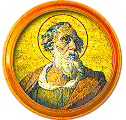Zephyrinus
(Pope St Zephyrinus)
Di Roma
Son of [father unknown] and [mother unknown]
[sibling(s) unknown]
[spouse(s) unknown]
[children unknown]
Died
[location unknown]
Profile last modified
This page has been accessed 91 times.
| Preceded by Victor 1 |
15th Pope of the Roman Catholic Church 198 - 217 or 218 |
Succeeded by Callixtus I |
Biography
Zephyrinus was born in Rome.[1][2]
He was consecrated Bishop of Rome in 198,[1] and remained pontiff for 18 years under persecution of Emperor Septimius Severus.[2]
He died in 217 or 218[1]. Flocknote Popes in a Year [3] tells us:
- The Liber Pontificalis (“Book of Popes”) lists Pope St. Zephyrinus as the 15th Bishop of Rome and 14th successor of St. Peter. Church historian Eusebius, writing around 325 AD, confirms the same.
- Most of what we know about Zephyrinus is from the Roman theologian Hippolytus. The good: Hippolytus was very thorough and detailed. The bad: Hippolytus had an axe to grind with the good pope (and, as it turned out, the next 3 popes, too).
- Hippolytus not only called the pope an idiot, but he accused Zephyrinus of modalism, a heresy which says the Father and Son are two names for the same person (as opposed to, you know, the Father and Son being two distinct persons).
- In reality, it appears Zephyrinus simply wasn’t educated in theology, instead preferring administration of the Church's daily duties, so he prudently refrained from speaking specifically on the subject either way. We don’t know when St. Zephyrinus was born, but he died December 20, 217 AD.
- Zephyrinus is known for a couple of different things. First, he gave the Church its 16th pope - St. Callixtus I. Callixtus was the pope’s archdeacon (basically the 3rd-Century equivalent of a secretary of state) but seems to have also been Zephyrinus’ counselor and main man for all things theology.
- Second, Zephyrinus reconciled the leader of a notorious heresy back to the Church. A priest named Natalius had been bribed into leading a group of heretics, but reportedly had many visions telling him to steer clear. According to Eusebius, Natalius finally wised up after being scourged by an angel one night. The next morning, he donned sackcloth and ashes (still fashionable for penitents back then) and “with great haste and tears” threw himself before Zephyrinus, who forgave him and welcomed him home.
- St. Zephyrinus was buried in the newly-created cemetery he'd appointed Callixtus to run. The cemetery, now known as the Catacomb of Callixtus, still exists today in Rome, though its relics were all moved to churches around Rome by the 9th Century.
- In the year 202, a Roman law banned female gladiators.
Sources
- ↑ 1.0 1.1 1.2 Vatican
- ↑ 2.0 2.1 Wikipedia Pope Zephyrinus
- ↑ Flocknote Popes in a Year
SOURCES (and further reading)
- John, E. (1964). The Popes: A concise biographical history. New York: Hawthorn Books.
- Pope St. Zephyrinus - http://www.newadvent.org/cathen/15756c.htm
- Pope Zephyrinus - https://en.wikipedia.org/wiki/Pope_Zephyrinus
- 200s A.D. - https://en.wikipedia.org/wiki/200s_(decade)
- Church History (Book V) - http://www.newadvent.org/fathers/250105.htm
Is Pope St Zephyrinus your relative? Please don't go away!
 Login to collaborate or comment, or
Login to collaborate or comment, or
 contact
contact
 the profile manager, or
the profile manager, or
 ask our community of genealogists a question.
ask our community of genealogists a question.
Sponsored Search by Ancestry.com
DNA
No known carriers of Pope St Zephyrinus's ancestors' DNA have taken a DNA test.
No known carriers of Pope St Zephyrinus's ancestors' DNA have taken a DNA test.
Have you taken a DNA test? If so, login to add it. If not, see our friends at Ancestry DNA.
Images: 1
Comments
Leave a message for others who see this profile.
There are no comments yet.
Login to post a comment.
D > Di Roma > Zephyrinus Di Roma
Categories: Roman Empire | Saints | 2nd Century | 3rd Century | Catholic Popes | Notables


